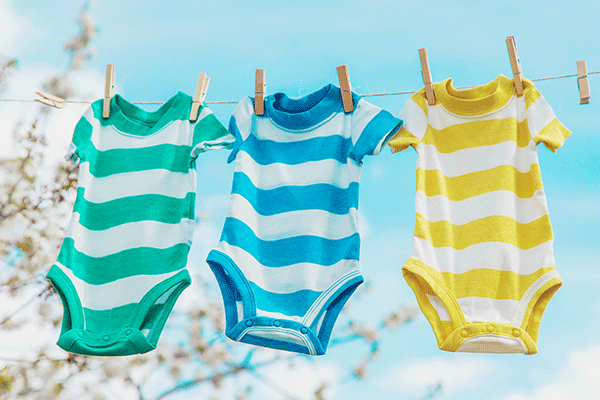10 things to know about saving and investing for a baby
24th August 2022 13:24
Amid a cost-of-living crisis, and no matter whether you have nine months to save for a baby or nine years, Nina Kelly suggests way to invest for a baby.

While children may be a bundle of joy, they are an expensive one, and when you consider all the items you need for a newborn, plus childcare costs, potentially having to move house to be close to a good school, and then, later, possibly paying private school fees and university tuition costs, it’s enough to make any prospective parent quiver.
- Learn about: Opening a Junior ISA | Free regular investing | Friends & Family
1) How much does having a baby cost?
So, how much does a baby cost? In 2020, figures from the Child Poverty Action Group, revealed that the cost of a child, from birth to age 18, was £71,611 for a couple family and £97,862 for a single-parent family. If housing and childcare costs are added in, the cost rises to £152,747 and £185,413 respectively.
These are sobering sums, especially considering that some would-be parents may require expensive rounds of IVF before a child even arrives.
But the actual costs will be different for everyone, so makes sense to sit down with your partner and work out a budget.
From nappies to new clothes, car seats to breast pumps, list exactly what you do need and work out how long you have to save for it. Don’t forget to list everything that’s relevant, such as the cost of a gender reveal party or a christening/naming day if you are planning such as event.
2) How can I protect myself?
It seems strange to think of death when you are considering a new life, but it’s vital to revisit your will – or establish one in the first place – if you are preparing for a major life event such as getting married/re-married, and/or having a child.
As well as allowing you to appoint guardians for your children, wills make clear at what age you want your child/children to inherit any assets, and how they would be provided for.
According to the UK consumer champion Which?, “whether you go to a solicitor, will writer or bank, simple wills start from about £80 and go up to several hundred pounds”. However, Which? says that for a more specialist will, such as one that includes trusts, you could pay a minimum of £500 to £600.
It’s also worth reviewing your pension ‘expression of wishes’ form once your baby has arrived. Your pension isn’t technically covered by your will, so it’s important to keep nominations up to date. Forms can be updated online through your pension provider’s website.
Also, consider whether you want to invest in life insurance, but check whether it is already part of your employee benefits package.
3) How does a baby affect my pension and retirement?
If one parent plans to take a career break or work part time to care for a young child, their personal pension contributions, as well as their income, obviously take a big hit.
Depending on how long the career break or part-time hours last, this could influence not only the age you can afford to stop work, but also your lifestyle in retirement.
Discuss with your partner how having children will influence your retirement plans, particularly if you are having children later in life, and envision potentially having to help young adult children with a house deposit when you are also thinking about your pension pots.

4) How much income will I get during parental leave?
There are reports of women getting into debt to cover maternity leave. Statutory maternity pay (SMP) is paid for up to 39 weeks, according to the gov.uk website. You receive 90% of your average weekly earnings (before tax) for the first six weeks, then £156.66 or 90% of your average weekly earnings (whichever is lower) for the next 33 weeks.
SMP is paid in the same way as your wages (for example, monthly or weekly) and tax and National Insurance will be deducted.
For Shared Parental Leave (where both parents share the caring responsibilities for their child), the rules for taking this type of leave and the pay are set by the government. If you qualify, you can share up to 50 weeks’ leave and up to 37 weeks of pay between you, so if this is an option you’d like to consider, be sure to examine your company’s policy.
Most employers offer enhanced maternity pay, and some may offer a generous enhanced paternity pay, so it really is worth working out exactly what’s on offer from your employer and what will work best for your family.
5) How does child benefit work?
You can claim Child Benefit as soon as you’ve registered the birth of your child. There are two rates: for the eldest or only child, you receive £21.80 a week. For each additional child, it is £14.45 a week.
Child Benefit is paid into your account every four weeks and there’s no limit to how many children you can claim for. You fill in a form available on the gov.uk website to claim (link).
However, earn more than £50,000? You may have to pay back some of your Child Benefit in tax if you (or your partner’s) individual income is greater than this sum.
6) How much does childcare cost?
In June 2022, a Trade Union Congress (TUC) analysis showed that the average annual nursery bill for a family with a child under two had increased by 44% since 2010, from £4,992 to £7,212 in 2021.
I personally know a couple, living in the South East, who pay £1,000 a month to put their two pre-school age children in nurseries.
Joeli Brearley, founder of the charity Pregnant then Screwed, which seeks to protect, support and promote the rights of pregnant women and mothers, said in July 2022 that: “Almost half of mothers are considering leaving their job due to childcare costs, while two-thirds say their childcare costs the same or more than their rent or mortgage.”
A useful place to start your research childcare costs may is this Childcare Choices page on gov.uk website and the website of national charity Coram Family and Childcare, which has a dedicated page on the subject.
Don’t forget to also check your eligibility for the government’s tax-free childcare scheme, too. This is paid to help parents in work with the cost of childcare. Myron Jobson, senior personal finance analyst at interactive investor, says: “The tax-free childcare scheme is a great money saver for eligible parents, effectively offering 20% off childcare up to £2,000 a year. But a large proportion of parents are still unaware of its existence.”

Picture credit: Silver Screen Collection/Hulton Archive/Getty Image
7) Should I consider a nanny?
If you are dreaming of a Mary Poppins-type character to care for your children, then you may prefer a nanny. Your local Family Information Service (FIS) – these are run by local authorities - should have details of registered nannies in your area.
Nannytax, a payroll firm, publishes an annual nanny salary index. Its 2021-22 report reveals that in London, the average annual gross salary is £39,806, while it is £35,438 in the Home Countries and Greater London, and £32,552 in the rest of the UK. The figures are based on a live-out nanny, working 50 hours per week.
Although such salaries may seem daunting, the report points out that “families are realising the cost-saving benefits of hiring a nanny when seeking childcare for multiple children, in comparison to nursery fees per child. 73% of our agencies confirmed that the cost of a nanny does not rise for additional children.”
If a nanny is beyond your budget, and you are thinking of an au pair from the Continent, you may need to recruit from further afield. The report says that “stricter rules post-Brexit mean au pairs from EU countries are no longer able to travel freely to the UK”.
8) What savings hacks can I use?
While you might be the lucky recipient of hand-me-down baby clothes and other items from friends and relations, not everyone is, but there are various ways for you to save money at this costly time.
My brother Adam’s baby arrived 11 weeks premature in May. “We hadn’t bought key items such as a pram,” said Adam. “When we weren’t with Jack at the neonatal unit, I wanted to feel productive to prepare for when we could take him home, so I started putting ‘junk’ from our garage on eBay.
“We were due to move house and I needed to clear out the garage anyway. I was surprised that items I assumed wouldn’t sell, were actually in demand. It’s strange sometimes, the things people want. The sale that gave me the biggest thrill was a spanner that sold for £24. Other items such as an old lawnmower sold for £18 and a motorcycling helmet for £150. In total, I made £756 to put towards a pram that costs £916.”
Given that babies cover their clothes in dribble, food – and worse – and often go through multiple outfits in a single day, consider second-hand clothing to help you cut costs. Websites such as Vinted can be good for picking up such items.
If you are in need of a dentist check-up, pick your moment wisely. Mothers-to-be are entitled to free NHS dental treatment while pregnant and for 12 months after the baby is born. The same is true for prescriptions. The money you save on dental costs can be invested instead.
9) How should I invest?
Timescale will dictate your saving and investing options. If you have only a couple of years to save, a savings account or fixed-rate-bond could be your safest option.
With inflation currently at 10.1% in the UK and interest rates slowly rising, the top regular savings account at the time of writing is paying 3.5%.
The best one-year fixed-rate-bond option as of end of August 2022 pays around 3.30%, according to Savings Champions, and on two-year bonds the best rates are around 3.47%.
However, if you have a five years-plus to save, then investing makes the most sense. In particular, regular monthly investing, which is offered by firms such as interactive investor. Investing on a monthly basis helps ‘smooth’ the peaks and troughs of stock market fluctuations through a process known as pound-cost averaging.
For example, if you are investing in a fund and the price is low that month, your money buys more of the fund, while the opposite is true during months when the price is high.
Rather than investing in individual equities, which are higher risk and more volatile, it could be safer to choose a diversified fund or an investment trust and be mindful of not putting all your eggs in one basket.
- Top 10 things you need to know about holding cash versus investing
- Watch our video on how to invest £10,000
Dzmitry, Lipski, interactive investor’s head of funds research, says: “While both actively managed and passive funds should be used by investors as a way of diversifying portfolios, I would pick actively managed and sustainable strategies to consider when investing for [a] baby over a long-term horizon.
One fund to consider is the Montanaro Better World Fund, which “invests in a concentrated portfolio of around 50 quality-growth companies, benchmarked against the MSCI World SMID index.”
Dipski comments that the fund, “invests in small and mid-cap companies, which aim to help solving some of the world’s major challenges by supporting the United Nations’ Sustainable Development Goals.” The fund managers have a strict selection process using a variety of tools to assess if a company is making a good impact.
Dipski explains that a smaller companies fund can form a useful part of a well-diversified portfolio. “Historically mid- and small-cap funds have outperformed their larger-cap counterparts over the longer term, but they’re generally considered to be more riskier investments, so should be used mainly for satellite allocation in a global well-diversified portfolio.”
Lipski has another suggestion for novice investors in the form of the BMO Sustainable Universal MAP Growth Fund, which is part of ii’s Quick-Start funds list.
This fund is focused on sustainable investing and Lipski comments that, “This option is a one-stop, hybrid solution that incorporates actively managed multi-asset and sustainable investing with a focus on low cost. It is designed to provide consistent long-term capital growth by using a medium to high level of risk and targets an annualised return of 4% above inflation over five years.”
10) What do I need to know about Junior ISAs?
Junior ISAs are a tax-free way to save for your children. Grandparents and other relatives can also pay money into JISAs, but they cannot open the account itself.
If you are a parent and an ii customer, you can open a Junior ISA for your child (under 18) and pay no more than your service plan is already costing you, so effectively that account for your son or daughter is ‘free’. Monthly regular investing at interactive investor is also free.
Most parents opt for cash ISAs, but it’s also worth considering a stocks and shares ISA. Kyle Caldwell, interactive investor’s deputy collectives editor, says that while cash may feel safe, its Achilles’ heel is inflation, which erodes its real value over time.
With inflation at its highest level for decades, investing is the best way to try and keep your money growing in real terms, although there are no guarantees. Any money invested for a baby will have 18 years to grow, so you can afford to take some risk given the long time horizon and the power of compounding.
Caldwell comments that: “In the first couple of months of disturbed sleep, opening a Junior ISA won’t be at the top of most parents’ to-do lists, but there’s a very good reason why it should not be put off for too long.
“The longer the money is invested, the greater the effect of compounding, which is the way in which investment returns themselves generate gains. For instance, if you invest £1,000 into a fund returning 5% over one year, you'll earn £50. Assuming that you don’t withdraw any money, the next year you'll earn 5% on £1,050, which is £52.50. This doesn’t sound like much of an uplift, but as each year passes, the compounding effect multiplies. The longer parents delay investing – the less time compounding has to work its magic.”
- Read ii Friends & Family customer stories
- 10 scenarios where a tax-efficient account is your friend
- ISA tips: funds and trusts investors can buy and forget about
On the interactive investor platform, the top three bestselling investments in Junior ISAs so far this tax year (6 April 2022 to 23 August 2022) are: Scottish Mortgage, Fundsmith Equity, and ES Investec Wealth & Investment Balanced Fund.
Caldwell says: “My two children have their Junior ISAs invested in ‘adventurous funds’ in the pursuit of potentially higher returns. The trade-off is greater risk. However, given the long timescale involved I am comfortable investing in this way.
“Both my children are invested in smaller company funds, one in Asia and the other child is invested globally. Over the long term, small company shares tend to outperform large ones, and my son and daughter have time on their side to allow this phenomenon to play out.”
One final thought: if the idea of your teenager accessing a large sum on their 18th birthday gives you nightmares, you can always use a proportion of your own adult ISA to invest for them, particularly given that most parents are unlikely to use the £20,000 maximum allowance each year.
These articles are provided for information purposes only. Occasionally, an opinion about whether to buy or sell a specific investment may be provided by third parties. The content is not intended to be a personal recommendation to buy or sell any financial instrument or product, or to adopt any investment strategy as it is not provided based on an assessment of your investing knowledge and experience, your financial situation or your investment objectives. The value of your investments, and the income derived from them, may go down as well as up. You may not get back all the money that you invest. The investments referred to in this article may not be suitable for all investors, and if in doubt, an investor should seek advice from a qualified investment adviser.
Full performance can be found on the company or index summary page on the interactive investor website. Simply click on the company's or index name highlighted in the article.
Please remember, investment value can go up or down and you could get back less than you invest. If you’re in any doubt about the suitability of a stocks & shares ISA, you should seek independent financial advice. The tax treatment of this product depends on your individual circumstances and may change in future. If you are uncertain about the tax treatment of the product you should contact HMRC or seek independent tax advice.
Editor's Picks